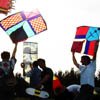Spitfire Two-Line Airplane Kite
This Spitfire is one of six kites that I made in 2012. It is based on a Guillows model kit, but I replaced the balsa spars with bamboo, and I strengthened many parts of the air frame using balsa wood. It is covered in Japanese washi paper in multiple layers and sealed with nitrate dope. It has no paint. I fly it on two very fine Spectra fishing lines that are 100 feet long. I hold a wooden dowel handle that is about a foot wide and fly it one-handed. It flies in the 50-70 mph range in a 15 to 20 mph wind. It pulls very hard so that I have to lean back in gusts, but it is very light, quick turning and fun to fly! Below I include articles on a family project that l led to building this and other similar kites, and a shorter article in which I attempt to explain how they fly.


